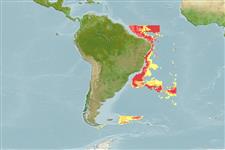分类 / Names
俗名 | 同种异名 | Catalog of Fishes(属, 种) | ITIS | CoL | WoRMS | Cloffa
Teleostei >
Scombriformes (Mackerels) >
Chiasmodontidae (Snaketooth fishes)
Etymology: Kali: Named after Kali, a Hindu goddess; colubrina: From the Latin coluber, snake; colubrina, feminine, snake-like. In a reference to the numerous recurved teeth in the upper and lower jaws, resembling the snakes of the family Colubridae.
Eponymy: Kali, also known as Kālikā (‘the black one’) is a Hindu goddess, often depicted as having four arms. (Ref. 128868), visit book page.
Environment: milieu / climate zone / depth range / distribution range
生态学
海洋 深海区的; 深度上下限 1000 - 2270 m (Ref. 75596), usually 1300 - 1800 m (Ref. 75596).
Western Atlantic (88°45’ W-38°19’ W, 27°48’ N and 19°50’ S): N Atlantic (Gulf of Mexico, Straits of Florida, off the Bahamas and Suriname) and S Atlantic (off Brazil). Indo-Pacific (off Indonesia), western South Pacific (off New Zealand) and the Pacific Plate, between 127°36’ E and 169°07’ E, 19°14’ N and 39°49’ S.
大小 / 重量 / 年龄
Maturity: Lm ? range ? - ? cm
Max length : 17.1 cm SL 雄鱼/尚未辨别雌雄; (Ref. 75596)
简单描述
检索表 | 型态特徵 | 形态测量图
A moderate-sized species of Kali and is distinguished from its congeners by the unique dentition pattern: teeth in lateral series of premaxilla 13-22, type 4, caniniform but not developed as fangs, recurved (vs. teeth in lateral series of premaxilla seven to 22; first tooth developed as fang in K. falx and K. indica; needle-like at least in the
anterior part of dentigerous area in K. kerberti, K. normani, and K. macrura; recurved, with ventral attachment in the posterior dentigerous area in K. macrura and entire dentigerous area in K. parri); teeth in mesial series of premaxilla five to nine, not developed as fangs (vs. teeth in mesial series of premaxilla three in K. falx and K. indica; four to five in K. kerberti, three to four in K. macrura; and six to fifteen in K. parri; developed as fangs in K. falx, K. indica; K. kerberti, and K. macrodon); teeth in lateral series of dentary eight to 18, type 4, caniniform but not very elongated, recurved (vs. teeth in lateral series of dentary seven to 22, elongated in K. falx and K. indica; needle-like at least in the anterior fourth of dentigerous area in K. kerberti, K. normani, and K. macrura; with ventral attachment, recurved, in the posterior dentigerous area in K. macrura, and entire dentigerous area in K. parri); teeth in mesial series of dentary six to ten, not developed as fangs (vs. teeth in mesial series of premaxilla two to four in K. falx and K. indica; four to five in K. kerberti, six to eight in K. macrura; and seven to 19 in K. parri; developed as fangs in K. falx, K. indica; K. kerberti, and K. macrodon).
Life cycle and mating behavior
成熟度 | 繁殖 | 产卵场 | 卵 | 孕卵数 | 仔鱼
Melo, M.R.S., 2008. The genus Kali Lloyd (Chiasmodontidae: Teleostei) with description of new two species, and the revalidation of K. kerberti Weber. Zootaxa 1747:1-33. (Ref. 75596)
世界自然保护联盟红皮书 (Ref. 130435: Version 2024-1)
人类利用
工具
特别资料
下载 XML
网络资源
Estimates based on models
Preferred temperature (Ref.
123201): 3.2 - 4.4, mean 3.9 °C (based on 31 cells).
Phylogenetic diversity index (Ref.
82804): PD
50 = 0.5078 [Uniqueness, from 0.5 = low to 2.0 = high].
Bayesian length-weight: a=0.00389 (0.00180 - 0.00842), b=3.12 (2.94 - 3.30), in cm total length, based on all LWR estimates for this body shape (Ref.
93245).
营养阶层 (Ref.
69278): 3.7 ±0.2 se; based on size and trophs of closest relatives
Fishing Vulnerability (Ref.
59153): Low vulnerability (11 of 100).
